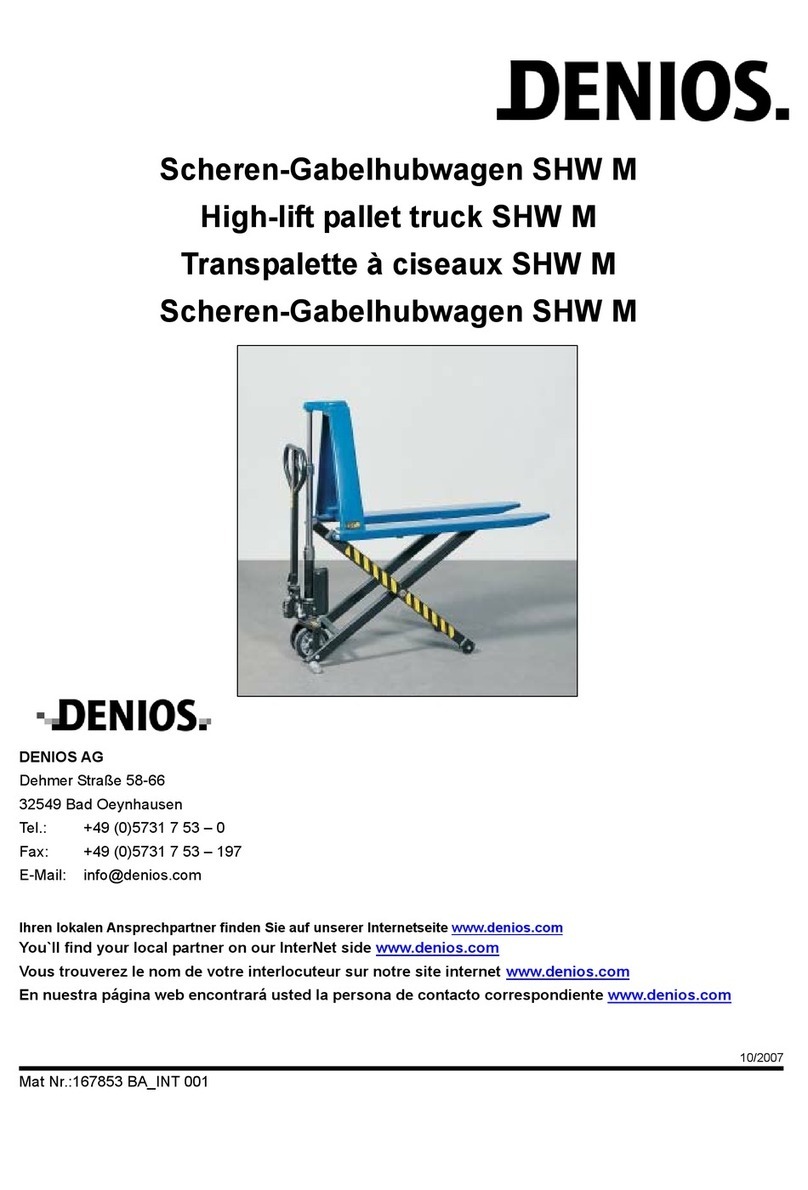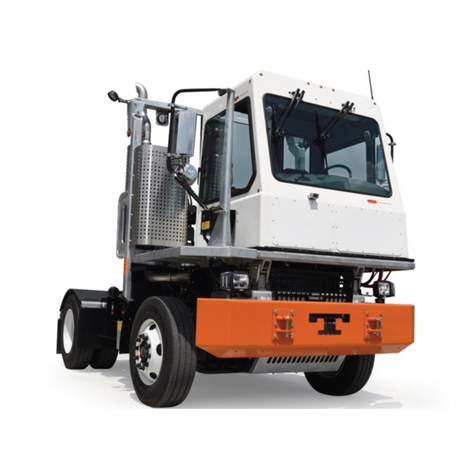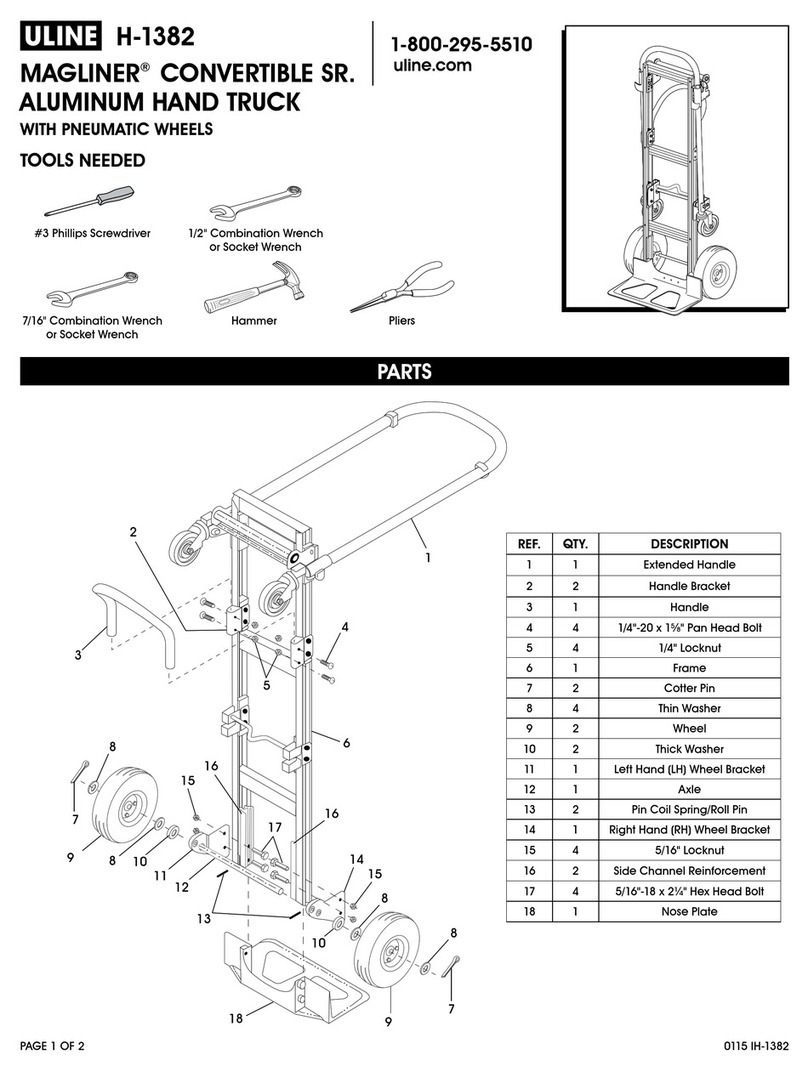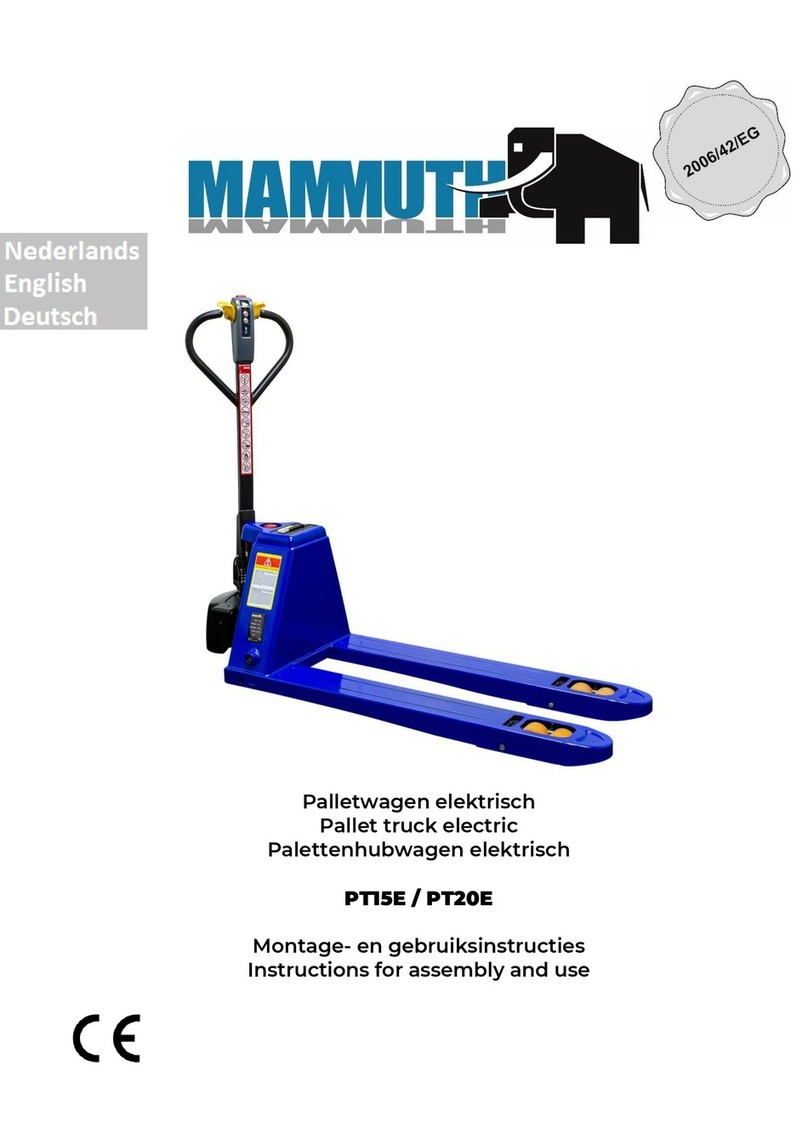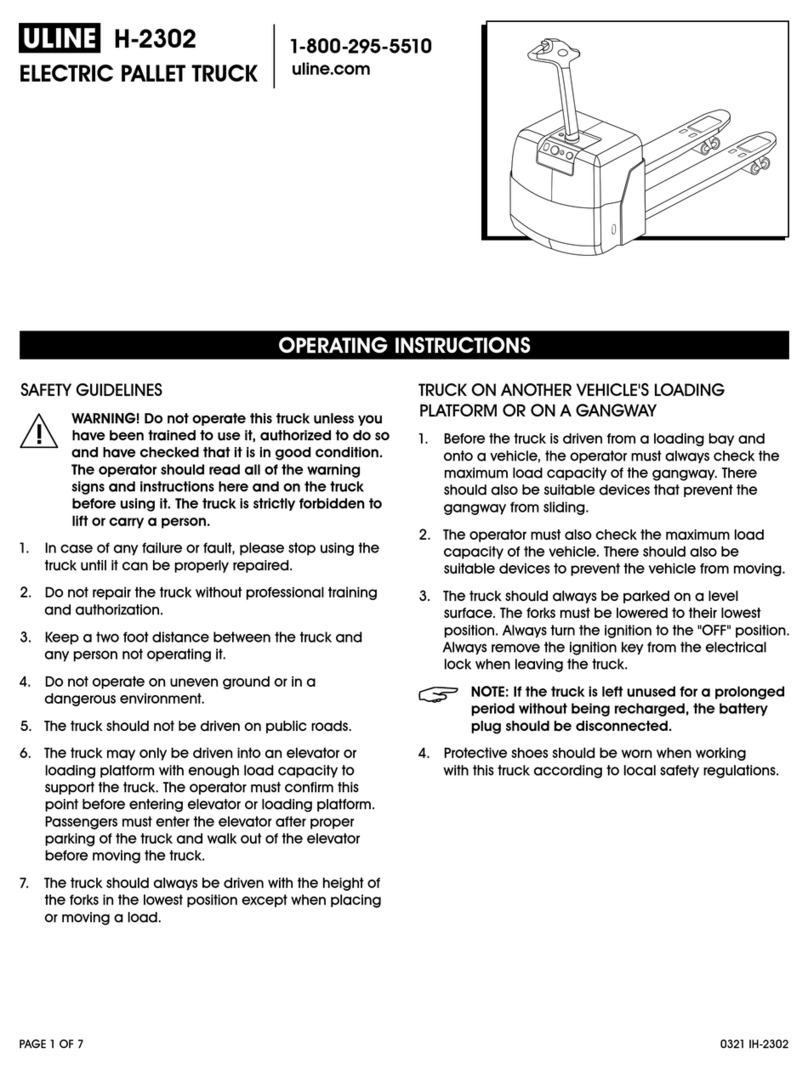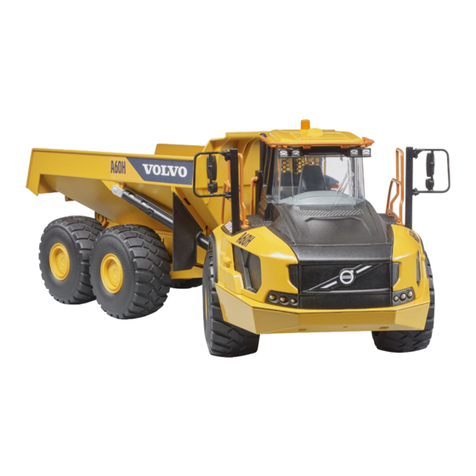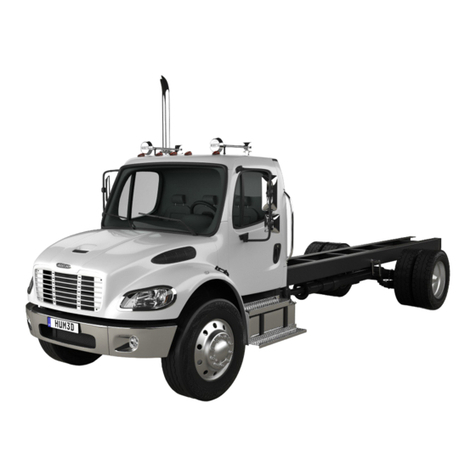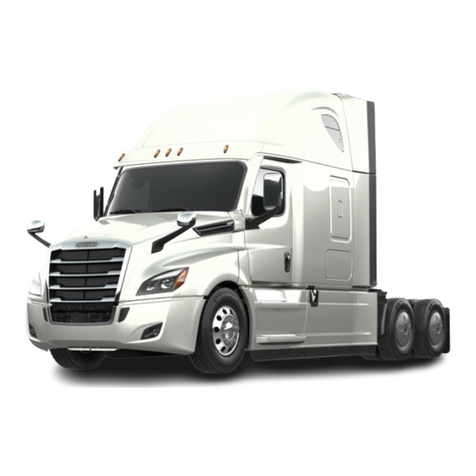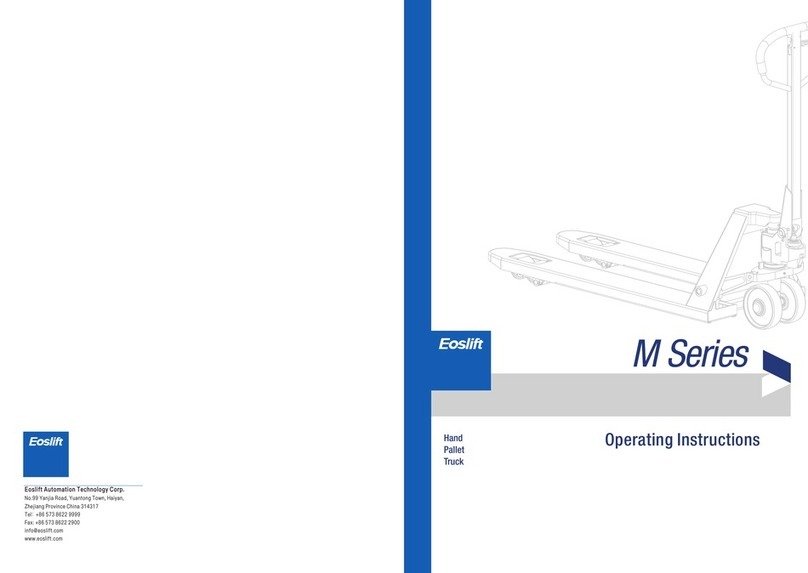Denios HW User manual

Gabelhubwagen HW / HWD
Hydraulic pallet truck HW / HWD
Transpalette hydraulique HW / HWD
Carretilla de horquilla elevadora HW / HWD
DENIOS AG
Dehmer Straße 58-66
D-32549 Bad Oeynhausen
Tel.: +49 (0)5731 7 53 - 122
Fax: +49 (0)5731 7 53 - 95 951
E-Mail: customerservice@denios.de
Ihren lokalen Ansprechpartner finden Sie auf unserer Internetseite www.denios.com
You`ll find your local partner on our InterNet side www.denios.com
Vous trouverez le nom de votre interlocuteur sur notre site internet www.denios.com
En nuestra página web encontrará usted la persona de contacto correspondiente www.denios.com
09/2011
170271_BA_INT_004

Gabelhubwagen HW/HWD Seite 2 von 35 Seiten Ausgabe 09/2011
128380;164485
Index
Deutsch ................................................................................................................................... 4
1. Allgemeine Hinweise ........................................................................................................................................ 4
2. Sicherheitshinweise.......................................................................................................................................... 4
3. Einsatz und Verwendungszweck...................................................................................................................... 4
4. Aufbau und Inbetriebnahme ............................................................................................................................. 4
5. Technische Daten............................................................................................................................................. 5
6. Betrieb .............................................................................................................................................................. 5
7. Wartung und Instandhaltung ...........................................................................................................................11
8. Konformitätserklärung .....................................................................................................................................11
English................................................................................................................................... 12
1. General Instructions ....................................................................................................................................... 12
2. Safety instructions .......................................................................................................................................... 12
3. Use and intended purpose ............................................................................................................................. 12
4. Assembly ........................................................................................................................................................ 12
5.Specifications................................................................................................................................................... 13
6. Operation........................................................................................................................................................ 13
7. Maintenance and servicing............................................................................................................................. 19
8. Declaration of conformity................................................................................................................................ 19
Français................................................................................................................................. 20
1. Indications générales ..................................................................................................................................... 20
2. Sécurité d´indication....................................................................................................................................... 20
3. Usage et employ............................................................................................................................................. 20
4. Montage.......................................................................................................................................................... 20
5. Données techniques....................................................................................................................................... 21
6. Fonctionnement.............................................................................................................................................. 21
7. Maintenance et entretien................................................................................................................................ 27
8. Certificat de conformité .................................................................................................................................. 27
Español.................................................................................................................................. 28
1. Aviso general.................................................................................................................................................. 28
2. Indicaciones de seguridad.............................................................................................................................. 28
3. Uso y campo de aplicación ............................................................................................................................ 28
4. Montaje........................................................................................................................................................... 28
5. Datos técnicos ................................................................................................................................................ 29
6. Funcionamiento.............................................................................................................................................. 29
7. Mantenimiento y conservación....................................................................................................................... 35
8. Declaración de conformidad........................................................................................................................... 35

Gabelhubwagen HW/HWD Seite 3 von 35 Seiten Ausgabe 09/2011
128380;164485
Pos. Deutsch Englisch Francais Espaol
103 Einbaufassung Fitting support de montage Montura de inserción
109 Achse Axle axe Eje
139H Verbindungsglied Connecting link élément d’assemblage Elemento de unión
140H Stellschraube Adjustable screw vis de réglage Tornillo de ajuste
H101 Deichsel Tow handle timon Lanza
H106 Schaltgriff Switch handle Poignée de commande Palanca de activación
H107 Stange und Kette Rod and chain barre et chaîne Vara y cadena
H109 Schraube Screw vis Tornillo
H110 Federring Spring ring rondelle-ressort Arandela de resorte
103
109 139H
140H
H101
H107
H106
H109
H110

Gabelhubwagen HW/HWD Seite 4 von 35 Seiten Ausgabe 09/2011
128380;164485
1. Allgemeine Hinweise
Ohne Genehmigungen des Herstellers dürfen keine Veränderungen, An- oder Umbauten am Produkt
vorgenommen werden. Für Veränderungen ohne Genehmigung des Herstellers wird keine Haftung übernommen
und die Gewährleistung erlischt.
Die nationalen Vorschriften und Sicherheitsbestimmungen sind zu beachten
2. Sicherheitshinweise
Vor der Benutzung ist das Produkt auf seine einwandfreie Funktion zu überprüfen. Bei auftretenden Mängeln, darf
es nicht eingesetzt werden!
- Die Hinweise der UVV „Flurförderfahrzeuge“ BGV D27 sind zu beachten und einzuhalten
- Nur für den vorgesehenen Gebrauch einsetzen!
- Gabelhubwagen darf nicht im angehobenen Zustand belassen werden.
- Die angegebene Tragfähigkeit darf nicht überschritten werden!
3. Einsatz und Verwendungszweck
Der hydraulische Gabelhubwagen ist geeignet zum Transportieren, Heben und Senken von gesicherter Ladung
auf Paletten.
Der Gabelhubwagen ist zum Befahren von festem und ebenem Erdboden geeignet.
Mit der integrierten Wiege- und Druckeinheit können die Ladungsgewichte ermittelt werden
Der Einsatz-Temperaturbereich liegt von –10°C bis + 40°C.
4. Aufbau und Inbetriebnahme
Lenkeinheit und Pumpeinheit montieren
Lösen Sie die Stellschraube (140H) auf dem gekröpften Verbindungsglied (139H).
Entfernen Sie drei Schrauben (H109) und drei Federringe (H110) von der
Einbaufassung (103).
Bringen Sie Die Deichsel (H101,) auf der Einbaufassung (103) an,
Bitte beachten: Führen Sie die Stange und Kette (H107) durch die Mitte
von Einbaufassung (103) und Achse (109)
Montieren Sie drei Schrauben (H109) mit Federringen (H110) wieder auf
der Einbaufassung (103) und ziehen sie sicher fest.
Heben Sie das gekröpfte Verbindungsglied (139H) an und haken Sie den
Stift an der Kette (H107) in die Vertiefung des Verbindungsglieds (139H).
Einstellen der Betriebsfunktionen
An der Deichsel des Hubwagens befindet sich ein Schaltgriff (H106) der in 3 Stellungen geschaltet werden kann
(siehe Fig. 1): LOWER=Senken, NEUTRAL=Transportieren, ASCENT=Anheben.
Wenn der Hubwagen nicht entsprechend der gewählten Schaltposition reagiert, kann dies durch Nachjustierung
der Stellschraube (140H) korrigiert werden. Nach der Justierung sind alle 3 Schaltpositionen zu überprüfen.
Deutsch
139H
140H

Gabelhubwagen HW/HWD Seite 5 von 35 Seiten Ausgabe 09/2011
128380;164485
5. Technische Daten
Hubwagen
Typ HW HWD
Ausführung inkl. Waage inkl. Waage +Thermodrucker
Traglast u. Wiegebereich (kg) 2000 2000
Teilung (kg) 1 1
Wiegetoleranz ± 1‰ ± 1‰
Eigengewicht (kg) 136 136
Hubbereich (mm) 85 bis 205 85 bis 205
Gabellänge (mm) 1150 1150
Tragbreite (mm) 555 555
Zinkenbreite (mm) 180 180
Einsatz in Temp.-bereich -,10°C bis +40°C 0°C bis +40°C
Drucker (nur Typ HWD)
Typ Papierrolle Auflösung Druck-
geschwindigkeit
Temperaturbereich Abmessungen Energieversorgung
Thermo-
drucker
Ø32 x 58 mm 203 DPI max 45 mm/s 0°C - +40 °C 77 x 77 x 44 mm 6 V DC
(4 x Mignon / AA)
6. Betrieb
Bitte beachten Sie die folgenden Hinweise zum sicheren Arbeiten mit dem Hubwagen.
Wir empfehlen beim Bedienen des Hubwagens Handschuhe und Sicherheitsschuhe zu tragen.
Auf korrekte Sicherung der Ladung achten.
Die angegebene Tragfähigkeit bezieht sich auf gleichmäßig verteilte Last.
Bei nicht-Nutzung die Gabeln absenken
Wählen Sie die gewünschte Arbeitsposition am Schaltgriff H106
gemäß Fig. 1
Achten Sie auf richtige Beladung gemäß Fig. 2
FIG: 2

Gabelhubwagen HW/HWD Seite 6 von 35 Seiten Ausgabe 09/2011
128380;164485
Heben der Gabeln
- Hebel in Hebe-Position
- durch auf und ab - Pumpbewegungen mit der Deichsel kann die Last auf die gewünschte Höhe angehoben
werden
Senken der Gabeln
- Hebel in Senk-Position
- die Gabeln senken sich langsam
Verfahren der Ladung
- Hebel in Neutral-Position
Beim Verfahren der Ladung dürfen die Gabeln nur leicht angehoben sein
6.1 Betrieb der Waage
Die Stromversorgung von Waage und Drucker erfolgt über vier Mignon-Zellen (4xAA), die im Lieferumfang
enthalten sind.
Zum Wechseln / Einsetzen der Mignon-Zellen müssen zunächst die beiden
Schrauben des Batteriefachs gelöst werden.
Senken Sie die Gabeln ab.
Schalten Sie die Waage mit der .Ф.. -Taste ein. In der Anzeige sollte „0,0“ erscheinen
Ist das nicht der Fall, muss der 0 - Punkt neu gesetzt werden.
Dazu müssen Sie die Taste →0←für 8 sec drücken. Die Anzeige im Display zählt von AF 08 bis AF 00 herunter.
Anschließend wird kurz im Display angezeigt, mit welcher prozentualen Genauigkeit der 0-Punkt gesetzt wurde.

Gabelhubwagen HW/HWD Seite 7 von 35 Seiten Ausgabe 09/2011
128380;164485
6.1.1 Ermitteln eines Brutto-Gewichts
1) Taste →0←drücken (Tara löschen) - Anzeige = 0,0
2) Last aufnehmen, Gabeln anheben - Anzeige = Brutto-Gewicht
3) Taste Σ....1x lang (3 Sek) und
gleich anschließend 1x kurz drücken - Wiegevorgang wird beendet und ausgedruckt (HWD
4) Gabeln absenken, Last entfernen
6.1.2 Ermitteln von Netto- und Brutto-Gewicht
1) Taste →0←drücken (Tara löschen) - Anzeige = 0,0
2) leere Palette aufnehmen, Gabeln anheben - Anzeige = Gewicht der Palette (z. B. 40 kg)
3) Taste →0←drücken - Anzeige = 0
4) Gabeln absenken - Anzeige = -40kg
5) Taste Σ..drücken - Tara wird registriert und ausgedruckt (bei Typ HWD)
6) Beladene Palette aufnehmen, Gabeln anheben - Anzeige = Netto-Gewicht
7) Taste Σ..drücken - Gewicht wird registriert und ausgedruckt (bei Typ HWD)
8) Taste Σ..lang (3 Sek) drücken - Addition von Tara und Netto-Gewicht wird angezeigt
9) Taste Σ.. 1x lang (3 Sek) und
gleich anschließend (während die Addition im-
Display läuft) 1x kurz drücken - Wiegevorgang wird beendet und ausgedruckt (HWD)
6.1.3 Ermitteln eines Netto-Gewichts
1) Taste →0←drücken (Tara löschen) - Anzeige = 0,0
2) leere Palette aufnehmen, Gabeln anheben - Anzeige = Gewicht der Palette (z. B. 40 kg)
3) Taste →0←drücken - Anzeige = 0
4) Gabeln absenken - Anzeige = -40kg
5) Beladene Palette aufnehmen, Gabeln anheben - Anzeige = Netto-Gewicht
6) Taste Σ..drücken - Gewicht wird registriert und ausgedruckt (HWD)
7) Taste Σ.. 1x lang (3 Sek.)und
gleich anschließend 1x kurz drücken - Wiegevorgang wird beendet und ausgedruckt (HWD)

Gabelhubwagen HW/HWD Seite 8 von 35 Seiten Ausgabe 09/2011
128380;164485
6.1.4 Ermitteln einer Summe von Gewichten
Addition mehrerer Brutto-Gewichte (Gewichte unter 20 kg werden nicht berücksichtigt)
1) Taste →0←drücken (Tara löschen) - Anzeige = 0,0
2) Last aufnehmen, Gabeln anheben - Anzeige = Brutto-Gewicht
3) Taste Σ..drücken - Gewicht wird registriert und ausgedruckt (HWD)
4) Gabeln absenken, Last entfernen - Anzeige = 0,0
5) Vorgänge 2-4 mit allen Einzellasten wiederholen
6) Taste Σ..lang (3 Sek.) drücken - Addition der Gewichte wird angezeigt
7) Taste Σ.. 1x lang (3 Sek.) und
gleich anschließend 1x kurz drücken - Wiegevorgang wird beendet und ausgedruckt (HWD)
Addition mehrerer Netto-Gewichte (Gewichte unter 20 kg werden nicht berücksichtigt)
1) Taste →0←drücken, (Tara löschen) - Anzeige = 0,0
2) leere Palette aufnehmen, Gabeln anheben - Anzeige = Gewicht der Palette (z. B. 40 kg)
3) Taste →0←drücken - Anzeige = 0
4) Gabeln absenken - Anzeige = -40kg
5) Beladene Palette aufnehmen, Gabeln anheben - Anzeige = Netto-Gewicht
6) Taste Σ..drücken - Gewicht wird registriert und ausgedruckt (HWD)
7) Gabeln absenken, Last entfernen - Anzeige = 0,0
8) Vorgänge 5-7 mit allen Einzellasten wiederholen
9) Taste Σ..lang (3 Sek.) drücken - Addition der Gewichte wird angezeigt
10) Taste Σ..1x lang (3 Sek.) und
gleich anschließend 1x kurz drücken - Wiegevorgang wird beendet und ausgedruckt (HWD)
6.1.5 Wechsel zwischen kg und lb
Sie können bei den Gewichtsangaben zwischen kg und lb wechseln, indem Sie kurz die .Ф.. -Taste betätigen.
6.1.6 Abschalten der Waage
Drücken Sie die .Ф.. -Taste für mindestens 2 Sekunden. Auf dem Display erscheint „off“, solange Sie die Taste
gedrückt halten. Danach erlöscht die Anzeige.

Gabelhubwagen HW/HWD Seite 9 von 35 Seiten Ausgabe 09/2011
128380;164485
6.2 Betrieb des Druckers (nur Typ HWD)
Ausdruck
Im Ausdruck ist ein ermitteltes Gewicht mit den Buchstaben „B/G“ gekennzeichnet, das Gesamtgewicht ist
gekennzeichnet mit den Buchstaben „TOT“.
Beispiel-Ausdruck (Fall 6.1.2):
01 B/G 40 kg Out*
02 B/G 158,2 kg
02 TOT 198,2 kg
Out*: Der Hinweis “Out” im Ausdruck dokumentiert das Gewicht der Palette
Nach jedem Ausdruck leuchtet die LED für kurze Zeit nach.
Der Papiervorschub funktioniert nur solange die LED leuchtet.
Wechseln des Druckerpapiers
- Schalten sie das Wiegesystem aus.
- Drücken sie vorsichtig auf den Hebel, um die Abdeckung zu öffnen.
- Legen sie die neue Papierrolle ein, dass das lose Ende muss oben im Drucker nach vorne zeigen.
- Schließen Sie die Abdeckung. Halten sie dabei das Ende der Papierrolle fest, so dass es zu sehen ist wenn der
Drucker geschlossen ist.
- Reißen Sie das überstehende Ende der Papierrolle an der Abreißleiste ab.
Abrissleiste
Abdeckung
Hebel
Papier Auswurf
LED
Blinkt 3 x Papierende
Blinkt 4 x Unter-/Überspannung
Dauerlicht Drucker empfängt
Schalter
(
ohne Funktion
)
Papiervorschub

Gabelhubwagen HW/HWD Seite 10 von 35 Seiten Ausgabe 09/2011
128380;164485
6.3 Störungen Hubwagen
Nr. Störung Ursache Beseitigung der Störung
1 die Gabel erreicht nicht
die Maximalhöhe. -zu wenig Hydrauliköl Öl nachfüllen.
2 die Gabel lässt sich
nicht heben.
-zu wenig Hydrauliköl
-das Öl ist verunreinigt.
-das Ablassventil ist nicht richtig
eingestellt
-Lufteinschlüsse im Hydrauliköl.
Öl nachfüllen.
Ölwechsel vornehmen.
Stellschraube justieren
Lufteinschlüsse entfernen
3 die Gabel lässt sich
nicht absenken.
-ein Bauteil ist aufgrund
unsachgemäßer Beladung zerstört
oder verformt.
-die Stellschraube (140H) ist falsch
justiert
-das Bauteil reparieren oder
austauschen.
-justieren Sie die Stellschraube
(140H)
4 Leckagen -Dichtungen abgenutzt oder beschädigt.
-einige Bauteile könnten abgenutzt oder
beschädigt sein
-Dichtungen ersetzen.
-Überprüfen und ersetzen.
5 die Gabeln senken sich
ungewollt.
-Unreinheiten im Öl blockieren das
Auslassventil
-Lufteinschlüsse im Hydrauliköl.
-Dichtungen abgenutzt oder beschädigt.
-Auslassventil ist nicht justiert.
-Ölwechsel.
-Lufteinschlüsse beseitigen
-Dichtungen austauschen.
-Justieren Sie die Stellschraube
(140H)
6 die Gabeln ruckeln -Lufteinschlüsse im Hydrauliköl. -im beladenen Zustand
Lufteinschlüsse beseitigen
6.4 Störungen Wiegeeinheit
Nr. Störung Ursache Maßnahme
1 Display-Anzeige
HELP1
- Die Ladung ist zu schwer - Entfernen Sie sofort die Ladung vom Hubwagen.
2 Display-Anzeige
HELP2
- tarieren nicht möglich
wegen negativem
Bruttogewicht
3 Display-Anzeige
HELP3
- negatives Signal der
Lastzellen auf dem AD
Wandler / Schiefstand
4 Display-Anzeige
HELP7
- das Signal der Lastzellen
am AD Wandler ist zu
hoch
5 Display-Anzeige
LO-BA
- der Akkuladezustand ist
zu niedrig
- laden Sie die Akkus oder tauschen Sie die Akkus
aus
6 Ungenaue
Gewichtsangaben
- Der “Fuss” der Gabel
berührt den unteren Teil
Waage
- Kabel in der Sensorbox ist
lose
- Eine der Wägzellen ist
defekt
- Keine der o. g. Ursachen
- Entfernen Sie Gegenstände die die Bewegung der
Skala einschränken.
- Überprüfen Sie die Verbindungen in der
Sensorbox nachdem sie den Hubwagen gesichert
haben.
- Stellen Sie sich auf die 4 Ecken der Waage. Wenn
eine der Wägezellen ein abweichendes Gewicht
anzeigt, wenden Sie sich bitte an die DENIOS-AG
- Die Waage muss evtl. neu kalibriert werden,
wenden Sie sich bitte an die DENIOS-AG
7 Display kann nicht
eingeschaltet
werden.
- Batteriespannung ist zu
klein
- Lebensdauer der Akkus ist
überschritten.
- Ladeinheit ist beschädigt.
- Laden Sie die Akkus.
- Tauschen Sie die Akkus durch neue aus
- Prüfen Sie Ausgangsspannung der Ladeeinheit,
tauschen Sie gegebenenfalls die Ladeeinheit aus.
8 Akkus können
nicht geladen
werden
- Akkus sind beschädigt.
- Ladeeinheit ist
beschädigt.
- Tauschen Sie Akkus durch neue aus
- Tauschen Sie die Ladeeinheit aus

Gabelhubwagen HW/HWD Seite 11 von 35 Seiten Ausgabe 09/2011
128380;164485
7. Wartung und Instandhaltung
Wichtig: Der Hubwagen darf nur von autorisiertem Personal gewartet werden
Hydraulik-Öl
Die Gesamt-Füllmenge des Ölbehälters beträgt ca. 0,3l. Der Ölstand muss in Interwallen von 6 Monaten
kontrolliert werden. Er ist optimal, wenn bei abgesenkten Gabeln 5 mm Luft zwischen Öloberfläche und Deckel
des Ölbehälters ist. Zum Nachfüllen verwenden Sie ein Öl gemäß folgender Angaben:
Temperatur Öl
-20℃- +40℃Hydraulik Öl entsprechend ISO VG 46
Lufteinschlüsse im Hydrauliksystem entfernen
Ein Austausch der Dichtungen kann zu Lufteinschlüssen im Hydrauliksystem führen. Um diese zu entfernen,
stellen sie den Schaltgriff (H106) in SENKEN-Position und bewegen dann die Deichsel mehrfach auf und ab.
Bewegliche Teile
Die beweglichen Bauteile des Gabelhubwagens müssen regelmäßig auf Leichtgängigkeit überprüft und
gegebenenfalls mit handelsüblichem Fett nachgeschmiert werden.
Nach Schadensfällen oder besonderen Vorkommnissen; die die Tragfähigkeit beeinflussen können, ist das Gerät
einer Prüfung durch einen Sachkundigen zu unterziehen
8. Konformitätserklärung
EG-Konformitätserklärung
Hiermit erklären wir, die DENIOS AG, Dehmer Straße 58-66, 32549 Bad Oeynhausen, dass das Produkt
mit den folgenden Richtlinien übereinstimmt.
Type: Gabelhubwagen HW / HWD
EG Richtlinien
Maschinenrichtlinie 2006/42/EG
Angewandte harmonisierte Normen
EN 1494
DIN EN 1757
EN 349
EN ISO 14121
EN 12100 -1,-2
EN 13857
Dokumentationsbevollmächtigter DENIOS AG, 04.01.2010
Herr Dr. Ing. R. Adenstedt Theodor Breucker
Technischer Leiter - Vorstand -

Gabelhubwagen HW/HWD Seite 12 von 35 Seiten Ausgabe 09/2011
128380;164485
1. General Instructions
No modifications or alterations can be made to the product without authorisation from the manufacturer, in the
event of this, the guarantee will be invalidated.
National standards and safety regulations must be observed.
2. Safety instructions
Before the product is used, it is to be checked for correct functioning. Should any defects appear, it must not be
used!
- The instructions of the accident prevention regulations for “industrial trucks” BGV D27 are to be observed
and complied with.
- Only use for the intended purpose!
- Pallet truck must not be left in raised position.
- The bearing capacity given must not be exceeded!
3. Use and intended purpose
The hydraulic pallet truck is suitable for transporting, lifting and lowering secured loads on to pallets.
The pallet truck is intended for moving on solid, even ground.
Weights of loads can be determined by the integrated weighing and pressure unit.
The operational temperature range is from –10°C to 40°C.
4. Assembly
Mounting steering unit and pump unit
Release the adjusting screw (140H) on the offset connecting link (139H).
Release three screws (H109) and three spring washers (H110) from the base
(103).
Attach the tow handle (H101) on the mounting position (103).
Please note: Take the rod and chain (H107) through the middle of the base
(103) and shaft (109)
Put the three screws (H109) with spring washers (H110) back on the base
(103) and tighten them.
Lift up the offset connecting link (139H) and hook the pin to the chain (H107)
in the hollow of the connecting link (139H).
Adjusting the operating modes
On the tow handle of the lifting trolley there is a switch handle (H106) that can be switched in 3 positions (see Fig.
1): LOWER =lowering, NEUTRAL = transporting, ASCENT = lifting.
If the lifting trolley does not react according to the chosen switching position, this can be corrected by subsequent
adjusting of the adjustment screw (140H). After setting, all 3 switch positions are to be tested.
English
139H
140H

Gabelhubwagen HW/HWD Seite 13 von 35 Seiten Ausgabe 09/2011
128380;164485
5.Specifications
Pallet truck
Type HW HWD
Model Incl. Scales Incl. Scales + thermal printer
Load capacity and weight range(kg) 2000 2000
Division (kg) 1 1
Weight tolerance ± 1‰ ± 1‰
dead weight (kg) 136 136
Lifting range (mm) 85 to 205 85 to 205
Length of forks (mm) 1150 1150
Width carrying area (mm) 555 555
Width of forks (mm) 180 180
Functions in temp. range -,10°C to +40°C 0°C to +40°C
Printer (only HWD version)
Type Paper roll resolution Printing
speed
Temperature range Dimensions Power supply
Thermal printer Ø32 x 58 mm 203 DPI max 45 mm/s 0°C to +40°C 77 x 77 x 44 mm 6 V DC
(4xMignon/ AA)
6. Operation
Please observe the following instructions for working safely with the pallet truck.
When operating the lifting truck we recommend wearing gloves and safety shoes.
Take care to correctly secure the load.
The given bearing capacity refers to an evenly spread load.
Lower the forks when not in use
Choose the desired working position on the handle switch H106 as on Fig. 1
Take care to load correctly as on Fig. 2

Gabelhubwagen HW/HWD Seite 14 von 35 Seiten Ausgabe 09/2011
128380;164485
Raising the forks
- Lever in lifting position
- By up and down pumping movements with the tow handle the load can be lifted to the desired height
Lowering the forks
- Lever in lowering position
- The forks lower slowly
Moving the load
- Lever in neutral position
When moving the load the forks must be only slightly raised
6.1 Operating the scales
The scales and printer are powered by four AA batteries, which are included in the delivery.
To replace or insert the AA batteries, you must first unfasten the two screws on
the battery cover.
Lower the lifting forks.
Switch on the scales by pressing the .Ф.. key. "0,0" should appear on the screen
If this is not the case, the "0" reading must be reset.
To do so, press the →0←key for 8 sec. The reading on the display will count down from AF 08 to AF 00.
A percentage will briefly appear on the display to indicate the accuracy rate for the new "0" setting.

Gabelhubwagen HW/HWD Seite 15 von 35 Seiten Ausgabe 09/2011
128380;164485
6.1.1 Measuring gross weight
1) Press the →0←key (deletes tare weight) - Display = 0,0
2) Pick up load, raise forks - Display = Gross weight
3) Press Σ....key once for a long time (3 sec) and then
immediately press again briefly
- Weighing procedure completed;
printed out on HWD model
4) Lower forks, remove load
6.1.2 Measuring net and gross weight
1) Press the →0←key (deletes tare weight) - Display = 0,0
2) Pick up empty pallet, raise forks - Display = Weight of pallet (e. g. 40 kg)
3) Press the →0←key - Display = 0
4) Lower forks - Display = -40kg
5) Press the Σ..key - Tare weight recorded and printed out
(on HWD model)
6) Pick up loaded pallet, raise forks - Display = Net weight
7) Press the Σ..key - Weight recorded and printed out
(on HWD model)
8) Press the Σ..key for a long time (3 sec) - Total tare and net weight added together is
displayed
9) Press the Σ..key for a long time (3 sec) and
then immediately press once again briefly (while the total
is on the display)
- Weighing procedure completed and printed out
(on HWD model))
6.1.3 Measuring net weight
1) Press the →0←key (deletes tare weight) - Display = 0,0
2) Pick up empty pallet, raise forks - Display = Weight of pallet (e. g. 40 kg)
3) Press the →0←key - Display = 0
4) Lower forks - Display = -40kg
5) Pick up loaded pallet, raise forks - Display = Net weight
6) Press the Σ..key - Weight recorded and printed out
(on HWD)
7) Press the Σ..key once for a long time (3 sec) and
then immediately press once again briefly
- Weighing procedure completed and printed out
(on HWD)

Gabelhubwagen HW/HWD Seite 16 von 35 Seiten Ausgabe 09/2011
128380;164485
6.1.4 Measuring a total sum of weights
Adding several gross weights together (weights under 20 kg are not included)
1) Press the →0←key (deletes tare weight) - Display = 0,0
2) Pick up load, raise forks - Display = Gross weight
3) Press the Σ..key - Weight recorded and printed out
(on HWD model)
4) Lower forks, remove load - Display = 0,0
5) Repeat steps 2 to 4 with all individual loads
6) Press the Σ..key for a long time (3 sec) - Total of weights added together is shown
7) Press the Σ..key once for a long time (3 sec) and
then immediately press once again briefly
- Weighing procedure completed and printed out
(on HWD)
Adding several net weights together (weights under 20 kg are not included)
1) Press the →0←key (deletes tare weight) - Display = 0,0
2) Pick up empty pallet, raise forks - Display = Weight of pallet (e. g. 40 kg)
3) Press the →0←key - Display = 0
4) Lower forks - Display = -40kg
5) Pick up loaded pallet, raise forks - Display = Net weight
6) Press the Σ..key - Weight is recorded and printed out (on HWD)
7) Lower forks, remove load - Display = 0,0
8) Repeat steps 5 to 7 with all individual loads
9) Press the Σ..key for a long time (3 sec) - Total of weights added together is shown
10) Press the Σ..key once for a long time (3 sec) and
then immediately press once again briefly
- Weighing procedure completed and printed out
(on HWD)
6.1.5 Changing between kilograms and pounds
You can change between metric and imperial weight readings by pressing briefly on the .Ф.. key.
6.1.6 Switching the scales off
Press the .Ф.. key for at least 2 seconds. "Off" will appear on the display while you hold down the key. The
display will then turn off.

Gabelhubwagen HW/HWD Seite 17 von 35 Seiten Ausgabe 09/2011
128380;164485
6.2 Using the printer (for HWD model only)
Printouts
The letters "B/G" indicate the weight measured; the letters "TOT" indicate total weight.
Example of a printout (as in 6.1.2):
01 B/G 40 kg Out*
02 B/G 158,2 kg
02 TOT 198,2 kg
Out*: The reference “Out” on the printout shows the weight of the pallet
The LED lights up for a short time after each printout.
The paper feed will only work if the LED is lit.
Changing the printer paper
- Switch the weighing system off.
- Push carefully on the lever to open the cover.
- Put the new roll of paper in, the free end must be at the top facing forward in the printer.
- Close the cover. Hold the end of the roll of paper tightly so that it can be seen when the printer is closed.
- Tear off the overhanging end of the roll of paper on the tear bar.
Tear bar
Cover
Lever
Paper out
LED
Flashes three times Paper finished
Flashes four times Under/overvoltage
Continuous light Printer receiving data, printing readout
Switch
(no function)
Paper feed

Gabelhubwagen HW/HWD Seite 18 von 35 Seiten Ausgabe 09/2011
128380;164485
6.3 Faults in the pallet truck
No. Fault Cause Solution
1 Forks do not reach
maximum height - Too little hydraulic fluid - Add more fluid
2 Forks cannot be raised
- Too little hydraulic fluid
- Fluid is contaminated
-The bleeder valve is not set correctly
- Air bubbles in the hydraulic fluid
- Add more fluid
- Change fluid
- Reset adjusting screw
- Remove air bubbles
3 Forks cannot be
lowered
- A component has been damaged or
warped by inappropriate loading
- The adjusting screw (140H) is
incorrectly set
- Repair or replace the component
- Reset the adjusting screw (140H)
4 Leakages
- Seals worn or damaged
- Some components may be worn or
damaged
- Replace seals
- Check and replace
5 Forks lower of their
own accord
- Impurities in the oil are blocking the
bleeder valve
- Air bubbles in the hydraulic fluid
- Seals worn or damaged
- Bleeder valve is not set correctly
- Change fluid
- Eliminate air bubbles
- Replace seals
- Reset the adjusting screw (140H)
6 The forks judder - Air bubbles in the hydraulic fluid - Remove air bubbles when loaded
6.4 Faults in scale unit
No. Fault Cause Solution
1 Display screen
HELP1
- Load is too heavy - Remove the load from the truck immediately.
2 Display screen
HELP2
- Taring not possible due to
negative gross weight
3 Display screen
HELP3
- Negative load cell signal in
the AD converter / not
level
4 Display screen
HELP7
- The load cell signal in the
AD converter is too high
5 Display screen
LO-BA
- Battery charge level is too
low
- Charge the batteries or replace them
6
Inaccurate weight
data
- The “foot” of the fork is
touching the lower part of
the scales
- Cable in the sensor box is
loose
- One of the weighing cells
is defective
- None of the above causes
- Remove objects that limit the movement of the
scale.
- Check the connections in the sensor box after
securing the truck.
- Stand on each of the 4 corners of the scales. If one
of the load cells displays a different weight, please
contact DENIOS-AG
- The scales may need to be re-calibrated,
please contact DENIOS-AG
7 Display cannot be
switched on.
- Battery voltage too low
- Service life of batteries is
exceeded.
- Charging unit is damaged.
- Charge the batteries.
- Replace the batteries with new ones.
- Test the output voltage of the charging unit,
replace it with another if necessary.
8 Batteries cannot
be charged
- Batteries are damaged.
- Charging unit is damaged.
- Replace the batteries with new ones.
- Replace the charging unit

Gabelhubwagen HW/HWD Seite 19 von 35 Seiten Ausgabe 09/2011
128380;164485
7. Maintenance and servicing
Important: The pallet truck must only be serviced by authorized staff
Hydraulic oil
The total capacity of the oil tank is approx. 0.3l. The oil level must be checked at intervals of 6 months. It is at the
optimum level when with forks lowered there is 5 mm of air between the surface of the oil and the lid of the oil tank.
To fill up use an oil according to the following data:
Temperature Oil
-20℃- +40℃Hydraulic oil according to ISO VG 46
Removing air bubbles in the hydraulic system
Changing the seals can lead to air bubbles in the hydraulic system. To remove these, put the switch handle (H106)
in the LOWER position and then move the tow handle several times up and down.
Moving parts
The moving components of the pallet truck must be checked regularly for ease of movement and if required
relubricated with commercially-available lubricating grease.
In the event of damage or particular incidents that can influence the bearing capacity, the device is to be subjected
to a test by a qualified person.
8. Declaration of conformity
EC Declaration of Conformity
Herewith we, the DENIOS AG, Dehmer Straße 58-66, D 32549 Bad Oeynhausen, declare that the product
complies with following guidelines.
Type: Hydraulic pallet truck HW / HWD
Safe working load: 2000 kg
EC Directives
Machinery directive 2006/42/EC
Harmonised standards applied
EN 1494
DIN EN 1757
EN 349
EN ISO 14121
EN 12100 -1,-2
EN 13857
Person responsible for documentation DENIOS AG, 04.01.2010
Mr. Dr. Ing. R. Adenstedt Theodor Breucker
Head of engineering - Board of governors -

Gabelhubwagen HW/HWD Seite 20 von 35 Seiten Ausgabe 09/2011
128380;164485
1. Indications générales
Aucune modification ou transformation du produit ne peut être effectuée sans l’accord préalable du fabricant.
Pour toute modification effectuée sans l'approbation du fabricant, aucune responsabilité ne sera prise en charge
et la garantie expirera immédiatement.
On doit observer des normes et les règlements nationaux de sûreté
2. Sécurité d´indication
Avant d’utiliser le produit, vérifiez que son fonctionnement est parfait. Il ne doit pas être utilisé si des défauts
apparaissent.
- Respectez impérativement les consignes figurant dans la directive D27 « Engins de manutention » de
l’association préventive des accidents du travail.
- Utilisez le produit uniquement pour l’usage prévu.
- Ne laissez pas les transpalettes avec les fourches soulevées.
- Ne dépassez pas la puissance de levage mentionnée.
3. Usage et employ
Le transpalette hydraulique peut soulever, abaisser et transporter des charges sécurisées sur palettes.
Le transpalette peut être déplacée sur des sols stables et plans.
Une balance et une imprimante permettent de déterminer le poids de la charge.
La plage de température d'utilisation est comprise entre – 10 °C et + 40 °C.
4. Montage
Montage de l’unité de direction et de la pompe
Desserrez la vis de réglage (140H) située sur l’élément d’assemblage coudé (139H).
Enlevez trois vis (H109) et trois rondelles-ressort (H110) du support de
montage (103).
Fixez le timon (H101) sur le support de montage (103). Attention : faites
passer la barre et la chaine (H107) au centre du support de montage (103) et
de l’axe (109).
Replacez les trois vis (H109) avec rondelles-ressort (H110) dans le support de
montage (103) et serrez-les.
Soulevez l’élément d’assemblage coudé (139H) et accrochez la tige de la
chaîne (H107) dans le creux de l’élément d’assemblage.
Réglage des fonctions opérationnelles
Le timon du chariot est équipé d’une poignée de commande (H106) à trois positions (voir fig. 1) : LOWER =
Abaisser, NEUTRAL = Transporter, ASCENT = Lever.
Si le chariot ne répond pas à la position choisie, ajustez la vis de réglage (140H). Vérifiez ensuite les trois positions.
Français
139H
140H
This manual suits for next models
1
Table of contents
Languages:
Other Denios Truck manuals
Popular Truck manuals by other brands
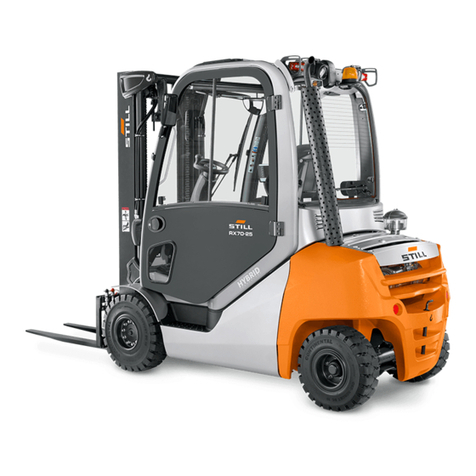
Still
Still RX70-20/600 Original instructions
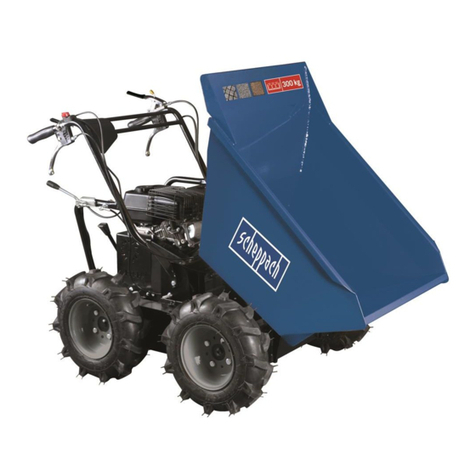
Scheppach
Scheppach DP3000 Translation from the original instruction manual

Trane
Trane Thermo King TriPac EVOLUTION installation manual

Volvo
Volvo FM 2 Series Service manual

Komatsu
Komatsu ecot3 HM350-2 Field assembly instructions
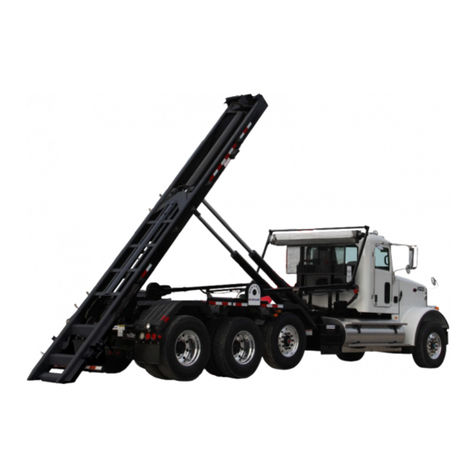
Galbreath
Galbreath U5-OR-194 Operation and maintenance
